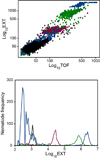Caenorhabditis elegans as a model in developmental toxicology
- PMID: 22669657
- PMCID: PMC3513774
- DOI: 10.1007/978-1-61779-867-2_3
Caenorhabditis elegans as a model in developmental toxicology
Abstract
A number of practical advantages have made the nematode Caenorhabditis elegans a useful model for genetic and developmental biological research. These same advantages, along with conservation of disease and stress response pathways, availability of mutant and transgenic strains, and wealth of biological information, have led to the increased use of C. elegans in toxicological studies. Although the potential to study the mechanisms of developmental toxicology in C. elegans is promising, embryonic and larval growth tests to identify compounds that affect the nematode have remained the primary use of C. elegans in developmental toxicology. Here, we describe a C. elegans larval growth and development assay for medium- and high-throughput screening using the COPAS Biosort flow cytometer and provide descriptions of the data and subsequent analysis.
Figures



Similar articles
-
High-Throughput Measurement for Toxic Effects of Metal Mixtures in Caenorhabditis elegans.Methods Mol Biol. 2021;2326:19-32. doi: 10.1007/978-1-0716-1514-0_2. Methods Mol Biol. 2021. PMID: 34097258
-
High-throughput COPAS assay for screening of developmental and reproductive toxicity of nanoparticles using the nematode Caenorhabditis elegans.J Appl Toxicol. 2019 Oct;39(10):1470-1479. doi: 10.1002/jat.3833. Epub 2019 Jul 9. J Appl Toxicol. 2019. PMID: 31287177
-
Medium- and high-throughput screening of neurotoxicants using C. elegans.Neurotoxicol Teratol. 2010 Jan-Feb;32(1):68-73. doi: 10.1016/j.ntt.2008.12.004. Epub 2009 Jan 6. Neurotoxicol Teratol. 2010. PMID: 19166924 Free PMC article.
-
Caenorhabditis elegans: an emerging model in biomedical and environmental toxicology.Toxicol Sci. 2008 Nov;106(1):5-28. doi: 10.1093/toxsci/kfn121. Epub 2008 Jun 19. Toxicol Sci. 2008. PMID: 18566021 Free PMC article. Review.
-
Caenorhabditis elegans, a Biological Model for Research in Toxicology.Rev Environ Contam Toxicol. 2016;237:1-35. doi: 10.1007/978-3-319-23573-8_1. Rev Environ Contam Toxicol. 2016. PMID: 26613986 Review.
Cited by
-
Two novel loci underlie natural differences in Caenorhabditis elegans abamectin responses.PLoS Pathog. 2021 Mar 15;17(3):e1009297. doi: 10.1371/journal.ppat.1009297. eCollection 2021 Mar. PLoS Pathog. 2021. PMID: 33720993 Free PMC article.
-
Effect of altered production and storage of dopamine on development and behavior in C. elegans.Front Toxicol. 2024 Aug 16;6:1374866. doi: 10.3389/ftox.2024.1374866. eCollection 2024. Front Toxicol. 2024. PMID: 39219718 Free PMC article.
-
Acute, Sublethal, and Developmental Toxicity of Kratom (Mitragyna speciosa Korth.) Leaf Preparations on Caenorhabditis elegans as an Invertebrate Model for Human Exposure.Int J Environ Res Public Health. 2022 May 22;19(10):6294. doi: 10.3390/ijerph19106294. Int J Environ Res Public Health. 2022. PMID: 35627831 Free PMC article.
-
Guidelines for the use of flow cytometry and cell sorting in immunological studies (second edition).Eur J Immunol. 2019 Oct;49(10):1457-1973. doi: 10.1002/eji.201970107. Eur J Immunol. 2019. PMID: 31633216 Free PMC article.
-
Culture and Assay of Large-Scale Mixed-Stage Caenorhabditis elegans Populations.J Vis Exp. 2021 May 5;(171):10.3791/61453. doi: 10.3791/61453. J Vis Exp. 2021. PMID: 34028439 Free PMC article.
References
-
- Sulston JE, Horvitz HR. Post-embryonic cell lineages of nematode, Caenorhabditis elegans. Dev. Biol. 1977;56:110–156. - PubMed
-
- Hope IA. C. elegans: A Practical Approach. Oxford: Oxford University Press; 1999.
-
- Riddle DL, Blumenthal T, Meyer BJ, Priess JR. C. elegans II. Cold Spring Harbor, NY: Cold Spring Harbor Laboratory Press; 1997. - PubMed
-
- Wood WB. The Nematode Caenorhabditis elegans. Cold Spring Harbor, NY: Cold Spring Harbor Laboratory Press; 1988.
Publication types
MeSH terms
Substances
Grants and funding
LinkOut - more resources
Full Text Sources
Other Literature Sources

